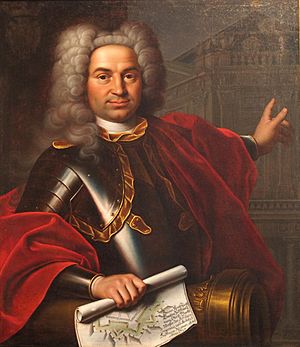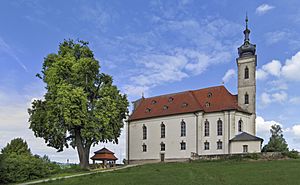Balthasar Neumann facts for kids
Quick facts for kids
Balthasar Neumann
|
|
|---|---|
 |
|
| Born |
Johann Balthasar Neumann
27 January 1687 (?) Eger, Bohemia, Holy Roman Empire
|
| Died | 19 August 1753 (aged 66) |
| Occupation | Architect |
| Buildings | Würzburg Residence, Basilica of the Fourteen Saints |
Balthasar Neumann (born Johann Balthasar Neumann; January 27, 1687 – August 19, 1753) was a famous German architect. He was also a military engineer. Neumann created a special style of Baroque architecture. He mixed ideas from Austria, Bohemia, Italy, and France. His designs led to some of the most amazing buildings of his time.
Two of his most famous buildings are the Würzburg Residence and the Basilica of the Fourteen Holy Helpers. The Würzburg Residence is seen as one of Europe's most beautiful palaces. Many people think the Basilica of the Fourteen Holy Helpers is his best work.
Contents
Early Life and Training
Balthasar Neumann was born in a town called Eger in January 1687. This town is now known as Cheb in the Czech Republic. He was one of nine children. His father was a cloth-maker.
When he was young, Neumann learned to work with bells and guns at a foundry. This was like an early apprenticeship. Later, he moved to Würzburg in 1711. He studied geometry, architecture, and land surveying. He also joined the local military. He stayed in the military until he died, reaching the rank of colonel. He even made tools for measuring and a map of Würzburg.
In 1717, he fought in a war against the Ottoman Empire. After that, in 1718, he traveled through northern Italy. He studied buildings there and worked on some small construction projects.
Working for the Prince-Bishops
Neumann's career as an architect really took off in Würzburg. This happened when Johann Philipp Franz von Schönborn became the Prince-Bishop. A Prince-Bishop was a ruler who was also a church leader. In 1719, the Prince-Bishop asked Neumann to plan a new palace. This palace became the famous Würzburg Residence. Neumann led the building work from 1720. Even though other architects helped, Neumann's ideas shaped the entire project. It became his life's most important work.
His next big project for the Prince-Bishop was the Schönbornkapelle at Würzburg Cathedral. This started in 1721. In 1723, Neumann traveled to France. In Paris and Versailles, he met famous royal architects. He asked them for advice on his Würzburg projects.
In 1725, Neumann married Maria Eva Engelberts. They had eight children together.
Under the next Prince-Bishop, Christoph Franz von Hutten, Neumann was less busy in Würzburg. He mostly worked for different abbeys (monasteries). His new church at Münsterschwarzach Abbey (started after 1727) made him famous for designing churches. Another important church from this time was at Kloster Holzkirchen (1728–1730). Here, he mixed French, Italian, and German Baroque styles.
The next Prince-Bishop was Friedrich Karl von Schönborn. He was also the Prince-Bishop of Bamberg. He made Neumann the head of all military, civilian, and church building projects in both areas. Neumann also taught architecture at Würzburg University starting in 1731.
Neumann also worked for other powerful church leaders. He built the main part of the Schloss Bruchsal palace (after 1731). This palace has a very famous staircase. He also designed the church of St. Peter in the same town. This church was meant to be the burial place for the Prince-Bishops of Speyer.
His work spread to western Germany. One of his most famous projects there was the staircase and new rooms at Brühl Palace (from 1743).
As a church builder, Neumann was inspired by other architects. He often used a round shape called a rotunda as a main part of his churches. This can be seen perfectly in Vierzehnheiligen (after 1742) and Neresheim (after 1747).
One of his last big plans was to rebuild the Hofburg Palace in Vienna. However, this plan was never built. He also worked on St. Paulinus' Church in Trier, designing many parts inside.
Death and Legacy
Balthasar Neumann died in Würzburg on August 19, 1753. He is buried in the Marienkapelle church there.
His importance is shown in many ways. His picture was on the old German 50 DM banknote. This note also showed the famous staircase in the Würzburg Residence. The artist Giovanni Battista Tiepolo even painted Neumann in the ceiling fresco above that staircase. In the painting, Neumann is in a military uniform, leaning on a cannon. This is because he once famously said that the ceiling was so strong, not even a cannon's roar would make it fall.
Other Notable Works
Neumann designed many other important buildings, including:
- The Propsteigebäude at Heidenheim (1723–1733).
- Several buildings in Bamberg, like the Katharinenspital (1729–1738) and the Domkapitelhaus (1730–1733).
- The pilgrimage church in Gößweinstein (1730–1739).
- The Orangerie at Schloss Seehof (1733–1737).
- The high altar of Worms Cathedral (1738–1740).
- The parish church in Heusenstamm (1739–1744).
- Several buildings in Würzburg, including the Geschäftshaus am Marktplatz (1739–1741) and the Käppele (1748–1749).
- The Kreuzkapelle in Kitzingen-Etwashausen (1741–1745).
- The parish church in Gaibach (1742–1745).
- The Jesuitenkirche in Mainz (1742–1746), which was later taken down.
- The abbey and convent building in Oberzell (1744–1760).
- The pilgrimage church in Maria Limbach (1751–1755), one of his final projects.
See also
 In Spanish: Johann Balthasar Neumann para niños
In Spanish: Johann Balthasar Neumann para niños





